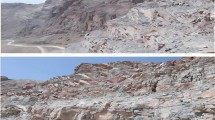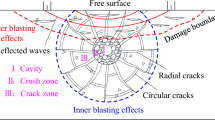Abstract
The impact of blast vibrations on cement-grouted rock is an unresolved challenge in construction projects where blasting is conducted near the grouted areas. This study investigates the blast vibration resistance of cement-grouted rock using both theoretical and experimental approaches. An analytical model is first presented based on structural characteristics and mechanical properties to describe the stress wave propagation in cement-grouted rock mass and to investigate the failure modes at its bonding interfaces. A model to calculate the safe vibration velocity (SVV) is then proposed to study the effects of the incident angle, in-situ stress, and bonding strength on cement-grouted rock. Next, an experiment was conducted to analyse the blast vibration resistance of cement-grouted rock and to validate the SVV model. Finally, several recommendations regarding safe blast vibration velocities for grouted areas were provided. The results indicate that cement-grouted rock has a high blast vibration resistance, which can be improved by increasing the incident angle, in-situ stress, or bonding strength. A normally incident wave was identified as the most dangerous for cement-grouted rock; thus, the SVV is the minimal in that case. For 3, 7, and 28-day-old cement-grouted rock, the SVV is suggested to be 6, 9, and 13 cm/s, respectively.















Similar content being viewed by others
Abbreviations
- \(t\) :
-
Time at which the incident wave arrives
- \(\vec{U}_{nm}\) :
-
Displacement field of a harmonic plane stress wave
- \(A_{nm}\) :
-
Displacement amplitude
- \(\vec{d}_{n}\) :
-
Unit vector in the direction of displacement
- \(i\) :
-
Imaginary number
- \(\vec{k}_{nm}\) :
-
Wave number
- \(\vec{p}_{n}\) :
-
Unit vector in the direction of wave propagation
- \(w\) :
-
Circular frequency
- \(\theta_{nm}\) :
-
Angle between the direction of wave propagation and the z-axis
- \(m \) :
-
The number of transmission and reflection of a given wave
- \(\vec{i}_{j}\) :
-
Unit vector of in the direction of the axis
- \(\lambda ,\mu\) :
-
Lame constants
- \(\sigma_{z1}\) :
-
z-Direction stress of the interface on the incident wave side
- \(\sigma_{z1}^{\prime }\) :
-
z-Direction stress of the interface on the transmitted wave side
- \(\sigma_{x1}\) :
-
x-Direction stress of the interface on the incident wave side
- \(\sigma_{x1}^{\prime }\) :
-
x-Direction stress of the interface on the transmitted wave side
- \(u_{z1}\) :
-
z-Direction displacements of the interface on the incident wave side
- \(u_{z1}^{\prime }\) :
-
z-Direction displacements of the interface on the transmitted wave side
- \(u_{x1}\) :
-
x-Direction displacements of the interface on the incident wave side
- \(u_{x1}^{\prime }\) :
-
x-Direction displacements of the interface on the transmitted wave side
- \(\sigma_{n0}\) :
-
In-situ stress parallel to the interface
- \(\tau_{0}\) :
-
In-situ stress perpendicular to the interface
- \(C\) :
-
Cohesion of the interface
- \(\varphi_{s}\) :
-
Static friction angle of the interface
- \(\sigma_{l}\) :
-
Additional tensile stress in the normal direction
- \(\sigma_{c}\) :
-
Additional compressive stress in the normal direction
- \(\sigma_{t}\) :
-
Ultimate tensile strength of the bonding interface
- \(\varepsilon_{t}\) :
-
Ultimate tensile strain of the bonding interface
- \(\varepsilon_{z}\) :
-
Strains in z- direction
- \(\varepsilon_{x}\) :
-
Strains in x- direction
- \(E\) :
-
Elastic modulus
- \(\rho\) :
-
Density
- \({\upnu }\) :
-
Poisson’ ratio
References
Achenbach JD (1973) Wave propagation in elastic solids. North-holland publishing company, London
Ainalis D, Oliver K, Jean-Pierre T, Olivier V, Georges K (2017) Modelling the source of blasting for the numerical simulation of blast-induced ground vibrations: a review. Rock Mech Rock Eng 50:171–193
Anthony B, Douglas D (1994) Introduction to elastic wave propagation. John Wiley & Sons Ltd, Chichester, England
Bandis SC, Lumsden AC, Barton NR (1983) Fundamentals of rock joint deformation. Int J Rock Mech Mining Sci Geomech 20(6):249–268
Boumiz A, Vernet C, Tenoudji FC (1996) Mechanical properties of cement pastes and mortars at early ages: evolution with time and degree of hydration. Adv Cem Based Mater 3(3–4):94–106
Cha M, Cho G, Santamarina JC (2009) Long-wavelength P-wave and S-wave propagation in jointed rock masses. Geophysics 74(5):E205–E214
Crouch SL (2010) Solution of plane elasticity problems by the displacement discontinuity method I infinite body solution. Int J Numer Meth Eng 10(2):301–343
Evdokimov PD, Adamovich AN, Fradkin LP, Denisov VN (1970) Shear strengths of fissures in ledge rock before and after grouting. Power Tech Eng 4(3):229–233
Gao Q, Lu W, Yang Z et al (2019) Analysis of evolution of seismic components induced by a vertical blasthole. Rock Mech Rock Eng 6(52):1959–1977
Houlsby AC (1990) Construction and design of cement grouting: a guide to grouting in rock foundations. John Wiley & Sons, Chichester, England
Ji JL, Li HJ, Yan GL (2008) Effect of temperature on ultrasonic wave velocity in concrete. J Build Mater 11(3):349–352 (in Chinese)
Ju Y, Sudak L, Xie H (2007) Study on stress wave propagation in fractured rocks with fractal joint surfaces. Int J Solids Struct 44(13):4256–4271
Kim JW, Chong SH, Cho GC (2018) Experimental characterization of stress and strain dependent stiffness in grouted rock masses. Materials 11(4):524
Laura J, Larry R, Neville G (1990) transmission of seismic waves across single natural fractures. J Geophys 95(86):8617–8638
Lee JS, Bang CS, Mok YJ, Joh SH (2000) Numerical and experimental analysis of penetration grouting in jointed rock masses. Int J Rock Mech Min Sci 37(7):1027–1037
Li J, Ma G (2010) Analysis of blast wave interaction with a rock joint. Rock Mech Rock Eng 43(6):777–787
Li J, Ma G, Huang X (2010) Analysis of wave propagation through a filled rock joint. Rock Mech Rock Eng 43(6):789–798
Li JC, Li HB, Jiao YY, Liu YQ, Xia X, Yu C (2014) Analysis for oblique wave propagation across filled joints based on thin-layer interface model. J Appl Geophys 102:39–46
Li Y, Wei PJ, Tang Q (2015) Reflection and transmission of elastic waves at the interface between two gradient-elastic solids with surface energy. Eur J Mech A Solids 52:54–71
Ministry of Water Resources and Ministry of Electric Power Industry of People’s Republic of China (2007) Construction technical specifications on rock-foundation excavating engineering of hydraulic structures (DL/T5389-2007). China Water Power Press, Beijing (in Chinese)
Ministry of Water Resources of People’s Republic of China (2001) Specifications for tests in water conservancy and hydroelectric engineering (SL264-2001). China Water Power Press, Beijing (in Chinese)
National Energy Administration (2013) Specifications of excavation blasting for hydropower and water resources projects (DL/T5135-2013). China Electric Power Press, Beijing (in Chinese)
Paine AS, Please CP (1994) An improved model of fracture propagation by gas during rock blasting—some analytical results. Int J Rock Mech Mining Sci Geomech 31(6):699–706
Resender R, Lamas LN, Lemos JV et al (2010) Micromechanical modeling of stress waves in rock and rock fractures. Rock Mech Rock Eng 43(6):741–761
She CX, Sun FT (2018) Study of the peak shear strength of a cement-filled hard rock joint. Rock Mech Rock Eng 51:713–728
Shui ZY, Li P, Dang SY (2000) Study on construction method to treat the dam clay core seat in Heihe River project. Water Resour Hydropower Eng 31(9):24–26 (in Chinese)
Swedenborg S, Dahlstrom LO (2003) Rock Mechanical Effects of Cement Grouting in Hard Rock Proceedings of the 2003 Specialty Conference on Grouting at the Third International Conference on Grouting and Ground Treatment. New Orleans: Grouting and Ground Treatment
Walsh JB, Brace WF (1966) Elasticity of rock: a review of some recent theoretical studies. Rock Mech Eng Geol 4(4):283–296
Wu WL (2012) Research on characteristics of rock joint before and after grouting. Jiangxi University of Science and Technology (in Chinese)
Wu W, Zhu JB, Zhao J (2013) Dynamic response of a rock fracture filled with viscoelastic materials. Eng Geol 160:1–7
Wu W, Li JC, Zhao J (2014) Role of filling materials in a P-wave interaction with a rock fracture. Eng Geol 172:77–84
Xu HF, Geng HS, Li CF, Chen W, Wang C (2013) Estimating strength of grouting reinforced bodies in broken rock mass. Chinese J Geotec Eng 35(11):68–72 (in Chinese)
Yan GR, Yang RQ, Zhou WY, Chen GX, Xiong J (1993) Exprimental study of the strength of high-pressure cement grouting reinforced rockmass under semobservation. Chin J Rock Mechan Eng 12(2):151–161 (in Chinese)
Zhang N, Hou CJ, Chen QM, Dai BB (1998) Mechanical properties of broken rock after grouting reinforcement. Rock Soil Mech 19(3):50–53 (in Chinese)
Zhao J, Cai JG (2001) Transmission of elastic P-Waves across single fractures with a nonlinear normal deformational behavior. Rock Mech Rock Eng 34(1):3–22
Acknowledgments
This work is supported by National Natural Science Foundation of China (Grant No. 51779193, No. 51479147). The authors wish to express their thanks to the supporters.
Funding
This work is supported by National Natural Science Foundation of China (Grant No. 51779193, No. 51479147). The authors wish to express their thanks to the supporters.
Author information
Authors and Affiliations
Corresponding author
Ethics declarations
Conflicts of Interest
The authors declare that they have no conflict of interest.
Additional information
Publisher's Note
Springer Nature remains neutral with regard to jurisdictional claims in published maps and institutional affiliations.
Rights and permissions
About this article
Cite this article
Deng, K., Chen, M., Wei, D. et al. Theoretical and Experimental Investigations of the Blast Vibration Resistance of Cement-Grouted Rock. Rock Mech Rock Eng 53, 4183–4199 (2020). https://doi.org/10.1007/s00603-020-02166-4
Received:
Accepted:
Published:
Issue Date:
DOI: https://doi.org/10.1007/s00603-020-02166-4




